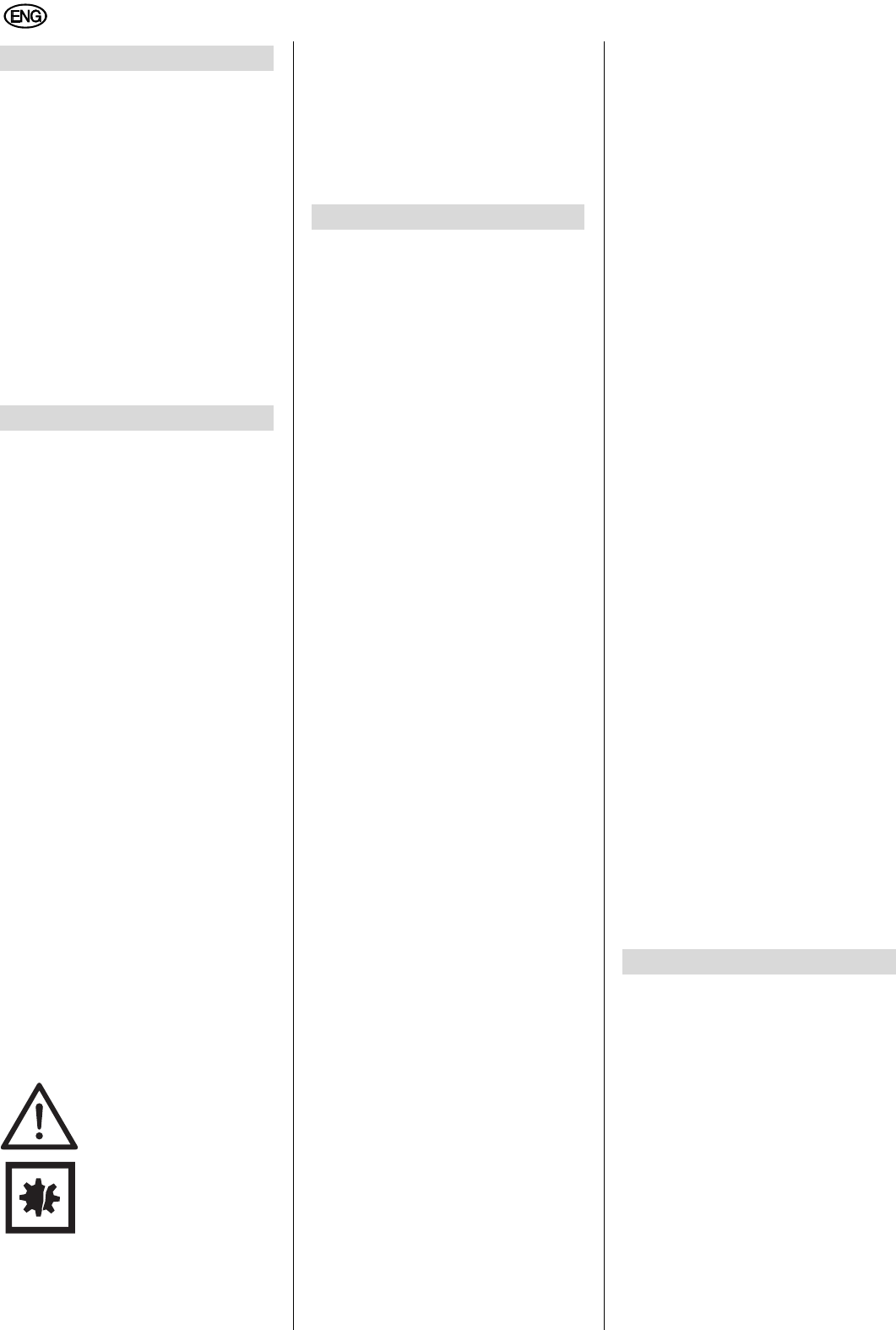
8
ENGLISH
1. Overview (Standard Delivery) ....7
2. Please Read First!.......................8
3. Safety ...........................................8
3.1 Specified conditions of use ...........8
3.2 General safety instructions............8
4. Operation .....................................8
4.1 Before initial operation ..................8
4.2 Using the tool ................................8
5. Care and Maintenance................9
6. Available Accessories ................9
7. Repairs .........................................9
8. Environmental Protection ..........9
9. Technical Specifications ............9
These instructions are written in a way to
let you work with the tool quickly and
safely. Here is how to use the instruc-
tions:
• Read these instructions fully before
operating the tool. Pay special
attention to the safety information.
• If you notice transport damage while
unpacking, notify your supplier
immediately. Do not operate the
tool!
• These instructions are intended for
individuals having a basic technical
knowledge in the handling of tools
like the one described herein. If you
have no experience whatsoever with
such tool, we strongly recommend
to seek the advise of experienced
individuals.
• Keep all documents supplied with
this tool for future reference. Also,
retain proof of purchase in case of a
warranty claim.
• Should you rent or sell the tool, pass
on all documents supplied with the
tool.
The manufacturer is not liable for any
damage arising from neglect of these
operating instructions.
Information in these instructions is
denoted as under:
Danger!
Risk of personal injury or
environmental damage.
Caution!
Risk of material damage.
− Numbers in illustrations (1, 2, 3, ...)
− denote component parts;
− are consecutively numbered;
− Instructions to be carried out in a
certain sequence are numbered.
− Instructions which can be carried
out in any sequence are indicated
by a bullet (•).
− Listings are indicated by an En Dash
(–).
3.1 Specified conditions of
use
This mini air saw is an air tool for use by
craftsmen. It can be used for cutting car
body panels or accurate to size cutting
of spars, crossheads, profiled sheets,
plastics, fibreglass, aluminium and
wood.
This tool shall only be powered by an air
compressor. The max. permissible work-
ing pressure stated in the Technical
Specifications must not be exceeded.
This tool must not be operated with
gases that are explosive, combustible or
detrimental to health.
Any other use is not as specified. Use
not as specified, modification of the tool
or use of parts not approved by the
equipment manufacturer can cause
unforeseeable damage!
3.2 General safety instruc-
tions
• When using this air tool follow the
safety instructions given below, to
exclude the risk of personal injury or
material damage.
• Please also observe the special
safety instructions in the respective
chapters.
• Observe the statuary accident insur-
ance institution regulations and reg-
ulations for the prevention of acci-
dents pertaining to the operation of
air compressors and air tools, where
applicable.
A
General hazards!
• Keep your work area tidy – a messy
work area invites accidents.
• Be alert. Do not operate this tool
while under the influence of drugs,
alcohol or medication.
• Keep children and bystanders away
from the work area.
• Store air tools out of the reach of
children.
• Always use a quick coupler to con-
nect this air tool to a compressor.
• Do not work materials detrimental to
health (e.g. asbestos sheets).
• Working with this tool may generate
sparks. Do not use the tool near
flammable materials, liquids or
gases.
• Edges of cuts and saw blades may
become hot during working. Let
workpiece and saw blade cool off.
• Disconnect from air supply before
− changing saw blades,
− servicing or
− when tool is left unattended.
• Use only saw blades intended for
this tool by the manufacturer.
A
Cutting hazard at the work-
piece!
When cutting metal sharp burrs will form
at the cut edges:
• Wear protective gloves.
• Deburr all edges.
A
Hazard generated by insuffi-
cient personal protection gear!
• Wear hearing protection.
• Wear safety glasses.
• Wear safety gloves.
A
Hazard generated by tool
defects!
• Do not attempt to repair the tool
yourself! Only trained specialists are
permitted to service or repair com-
pressors, pressure vessels and air
tools.
A
Caution!
• Protect the tool, air inlet, collet
chuck and operating elements in
particular, from dust and dirt.
• Make sure that the max. permissible
working pressure stated in the Tech-
nical Specifications is not exceeded.
The working pressure must be
adjusted by a pressure regulator.
• Do not overload tool – use it only
within the performance range it was
designed for (see Technical Specifi-
cations).
• Let tool run idle for a short time only.
4.1 Before initial operation
• Install swivel-type air inlet.
• Fit the plug nipple.
4.2 Using the tool
A
Caution!
To ensure a long service life of
this tool, it needs to be supplied with
sufficient quantities of pneumatic oil.
This can be achieved by:
− a service unit with oiler at the
compressor.
− a lubricator, installed in the air
line or directly on the air tool.
Table of Contents
2. Please Read First!
3. Safety
4. Operation


















